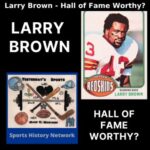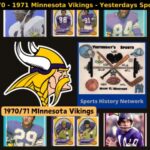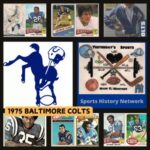Today we’re going to discuss the 1970s rivalry between the Oakland Raiders and the Pittsburgh Steelers. The Raiders joined the American Football League in 1960 and sputtered. The team notched only three winning seasons in its first seven years. That direction changed in 1967 when the Raiders went 14–1 before losing to the Packers in Superbowl II.
Oakland continued winning over the next three seasons, but each time the team finished one game short of reaching the Super Bowl. Things got worse in 1971 when the team failed to reach the playoffs, but 1972 was a turnaround year. Oakland went 10-3-1 and was back in the playoffs. They’d play the Pittsburgh Steelers.
Those Steelers weren’t much of a story until 1972. The longtime NFL member (from 1933) was a mediocre (at best) franchise. From 1933–1971, Pittsburgh reached the playoffs only once–in 1947.
Fortunes began to change in 1969 when the Steelers hired Chuck Noll as head coach. Noll built a foundation for winning, but it took time. In his first three seasons at the helm, Noll only went 12–30.
Steelers Fans Had Hope
Steelers’ fans had hope, though, mainly because of the players Noll was bringing to Pittsburgh. Among them were D-linemen Joe Greene and LC Greenwood, along with O-lineman Jon Kolb–all of whom were drafted in 1969. 1970 brought cornerback Mel Blount and quarterback Terry Bradshaw. In 1971, D-lineman Dwight White and linebacker Jack Ham joined the team. In 1972, running back Franco Harris became a Steeler.
Fans thought it would only be a matter of time before the Steelers’ draft picks would pay off. They were right. The payoff came in 1972 when Pittsburgh finished the season 11–3 and made the playoffs. The Raiders awaited.
The two teams had played each other during the regular season in a high-scoring offensive affair. Pittsburgh came out on top 34-28.
The playoff game would be a hard-hitting defensive battle. The Steelers led 3–0 after three-quarters. In the 4th quarter, Pittsburgh added another field goal to take a 6–0 lead.
Raiders’ coach John Madden knew he had to do something to shake up his stagnant offense. The solution was to bring in QB Ken Stabler and sit starter Daryle Lamonica. Madden’s strategy worked. Stabler ran 30 yards for a touchdown with just minutes remaining. With a successful PAT, the Raiders led 7–6.
The Immaculate Reception
The Steelers got the ball with just over a minute to play. On fourth down–and with only 22 seconds remaining in the game–Terry Bradshaw had perhaps one last chance. He dropped back to pass and was immediately under heavy pressure by the Raiders’ pass rush. Bradshaw ran to his right and threw the ball over the middle to running back John Fuqua.
What happened next will forever be a matter of dispute.
The ball may have bounced off Fuqua’s hands, or perhaps it got batted away by safety Jack Tatum. Either way, it looked like an incomplete pass. But just as the ball was about to hit the ground, running back Franco Harris scooped it up and ran it in for a touchdown.
But wait! The referees hadn’t signaled a touchdown. Had the ball hit the ground before Harris scooped it up? If so, it was an incomplete pass. Had the ball bounced off Fuqua? The rule at the time was that a ball could not be touched by two players on the same team–unless a player on the opposing team had also touched the ball.
After a long delay, which included a phone call to the league office, the referee finally signaled a touchdown.
It was called “The Immaculate Reception.” The Steelers won, and a rivalry was born.
Time For Revenge
After playing that historic game in Pittsburgh in December 1972, the Raiders didn’t have to wait too long to try and even things up. On November 11, 1973, they played the Steelers again, this time at home. But they lost once again, 17–9, as Daryle Lamonica threw four interceptions to seal the defeat.
The two teams met again in the playoffs on December 22, 1973, in Oakland. This time the Raiders got revenge, winning easily 33–14. Oakland gained 232 yards rushing against ‘The Steel Curtain’ defense. Pittsburgh rushed for only 65 yards.
On September 29, 1974, the Raiders humiliated the Steelers, 17–0, in Pittsburgh. The Steelers vowed revenge. Three months later, they got their chance.
3 Years In A Row
For the third year in a row, the two teams met in the postseason. This time, it was in the AFC Championship game. Pittsburgh got there by beating the Buffalo Bills. The Raiders arrived with fanfare–disposing of the defending Super Bowl champ Miami Dolphins in one of the most thrilling playoff games ever played.
With the Dolphins out of the picture, many fans and experts predicted that the Raiders would win their first Super Bowl. They had good reasons to think that way, too. Oakland boasted a 13–2 record going into the championship game, and they had just beaten the team that had won the last two Super Bowls.
For their part, the Steelers were tired of hearing how great these Raiders were.
Another Matchup
Gameday arrived on December 29. The game, played in Oakland this time, was another hard-hitting defensive battle. The Raiders lead 10–3 after three quarters but, then inexplicably, Oakland’s ‘D’ collapsed in the 4th quarter. Franco Harris gained 111 yards, and Rocky Bleier added 98 yards. The Steelers won 24–13 and went on to win the Super Bowl.
The teams met again in the 1975 AFC Championship.
The bad blood got thicker after Steelers’ coach Chuck Noll accused Raiders’ owner Al Davis of sending spies to Steelers’ practices. On gameday, Davis accused Noll of allowing the artificial turf at Three Rivers Stadium to freeze.
Davis saw it as a tactic to slow down Cliff Branch, the Raiders’ speedy wide receiver. The game-time temperature that day was just 15 degrees F.
It was another defensive battle. The Steelers lead 3–0 after three quarters, and–once again–most of the scoring came in the last stanza. With the Steelers leading 16–10, and with only nine seconds remaining, the Raiders recovered an onside kick and drove to the Steelers’ 15-yard-line as time expired.
It was another hard-hitting, ugly game. There were twelve turnovers and numerous cheap shots, including a blow to the head that resulted in a concussion for Lynn Swann–courtesy of Oakland DB George Atkinson. Teammate Joe Greene carried Swann off the field. Swann got the last laugh, though. Pittsburgh went on to win its second Super Bowl, and Swann was named the game’s MVP.
Rivalry Stands
And this fierce rivalry wasn’t over. Eight months later, the two teams met again, this time in the 1976 season opener. No defensive-minded or one-sided game was this. Pittsburgh had a comfortable 28–14 lead in the 4th quarter when the Raiders came storming back to win, 31–28.
But like so many of these Raiders-Steelers contests, the game featured smash-mouth play. There were 17 penalties and many big hits and cheap shots. George Atkinson was back at it again. He delivered a forearm to the back of Lynn Swann’s head in a play that was away from the action. A cheap shot with the intent to injure Swann suffered another concussion. The hit so-infuriated Steelers coach Chuck Noll that he called the Raiders “the criminal element” of the NFL. But in truth, the Steelers were no choir boys either. Earlier in the game, Mel Blount picked up the Raiders diminutive receiver Cliff Branch and dropped him on his head.
Four months later, the teams met again in Oakland. It was the fifth year in a row that the two sides had played each other in the postseason. The Raiders won 24–7 in a prelude to winning their first of three Super Bowls.
Some people believed the score would have been a lot closer or that the Steelers might have won that game if their starting running backs Franco Harris and Rocky Bleier had played (both players were unable to play due to injuries). But a regular-season rematch nine months later at Three Rivers Stadium dispelled that belief. Oakland prevailed again 16-7 and held Harris and Bleier to a combined 87 yards rushing.
The two teams didn’t meet again until September 1980. The Raiders won 45–34 that day but, by then, the rivalry had lost its luster. For all intent and purposes, the fiercely contested 6-year war ended.
But make no mistake about it. From 1972–1977, there were few rivalries as intense as the Raiders v. Steelers. It’s etched in NFL lore–never to be forgotten, always to be honored.
Learn more about The Outlaw Raiders from Rich Shmelter and The Football History Dude.
If you enjoyed Mark’s recollection of the Raiders vs. Steelers rivalry of the 1970s, you should also check out his recounts of the Dallas Cowboys and Washington Redskins through the 1970s and 80s.
Mark Morthier is the host of Yesterday’s Sports, a podcast dedicated to reliving memorable sports moments from his childhood days and beyond. He grew up in New Jersey just across from New York City, so many of his episodes revolve around the great sport’s teams of the 70s for the New York area.
He is also an author of No Nonsense, Old School Weight Training (Second Edition): A Guide for People with Limited Time and Running Wild: (Growing Up in the 1970s)

Please Note – As an Amazon Associate I earn from qualifying purchases
Resources
More From Yesterday's Sports
Muhammad Ali’s Chin: Knocked Down Only 4 Times
Muhammad Ali’s boxing career is well documented, so instead of...
Read MoreLarry Brown – Is He Hall of Fame Worthy?
A committee member recently asked me my opinion on inducting...
Read More1970s Minnesota Vikings : Would A Better QB Helped Them Win A Super Bowl?
Here’s a question I often hear, especially from Minnesota Vikings...
Read More1975 Baltimore Colts: A Year In Review
From 1957 to 1971, the Baltimore Colts never experienced a...
Read More




